5 Things You Should Avoid Wearing While Getting A Tattoo
There are plenty of things you can do to make your next (or first!) tattoo go more smoothly. For example, it can help to avoid alcohol, moderate your caffeine intake, and get some sleep the night before your tattoo appointment. On the day of your session, skip the gym, stay well-hydrated, and eat well before you sit down for your tattoo. From the inside out, these steps will help ensure your body is well-prepared to handle the physical strain of getting a tattoo. But have you thought about how you dress for your appointment?
Deciding what to wear may not be your main concern when you’re getting a new tattoo, but the fit of your “fit” can make a huge difference in your comfort level — and even the healing process. To get more details on this often-overlooked consideration, Glam spoke exclusively with Brooklyn-based needle-based tattoo artist Rosa Bluestone Perr.
First off, Perr says there are no hard and fast rules or dress codes for getting a tattoo. “As an artist, I see my clients in private and my studio is a safe space, so you can wear whatever you want,” Perr tells Glam. “This is totally up to the client!” Still, the artist does have some recommendations on ideal tattoo attire, including things to avoid like form-fitting silhouettes or snowy white clothing, which could prove uncomfortable or impractical during the appointment.
Tight, Restrictive Clothing will Add to Your Discomfort
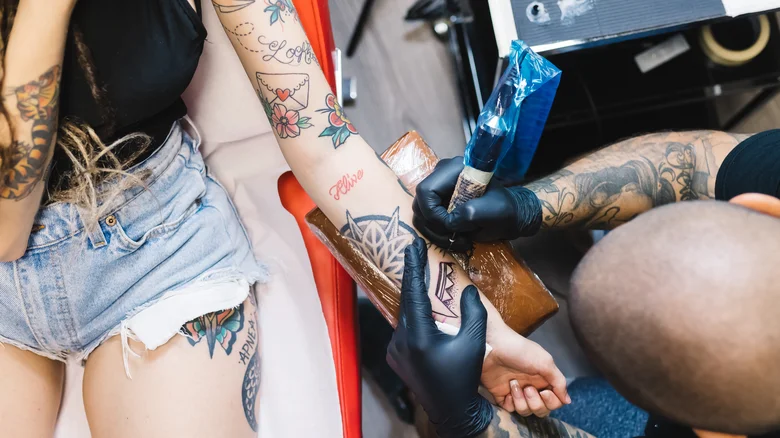
Tattoos have become incredibly popular in recent years, but for many people, the process itself isn’t the fun part. Depending on the placement of the design (different parts of the body have more or less painful tattoos), the experience of getting a tattoo can range from uncomfortable to downright agonizing. Who would have imagined that getting repeatedly pricked by needles could hurt?
That’s why it’s so important to dress comfortably. “When getting a tattoo, I recommend wearing something comfortable and loose,” Rosa Bluestone Perr exclusively tells Glam. This will put less unnecessary strain or friction on other parts of your body, minimizing your overall discomfort. For example, do you really want to sit in the same position for six hours while also being squeezed into a boning corset? Instead, think about the type of clothing you probably like to sleep in—soft, loose, lightweight garments will help your body feel comfortable. Breathability helps, too: Not only are fabrics like cotton and linen more comfortable to the touch, but they can also help keep your skin cool and dry during your session.
Also, keep in mind how you’ll be positioned during the tattoo. For example, Perr says, “I like my clients to lie completely flat to make the experience more relaxing.” Some tattoo placements may require a slightly awkward position, so choose clothing that’s flexible and covers any parts you don’t want to be unexpectedly exposed.
Clothes that Block the Placement of Your Tattoo are Big No-Nos
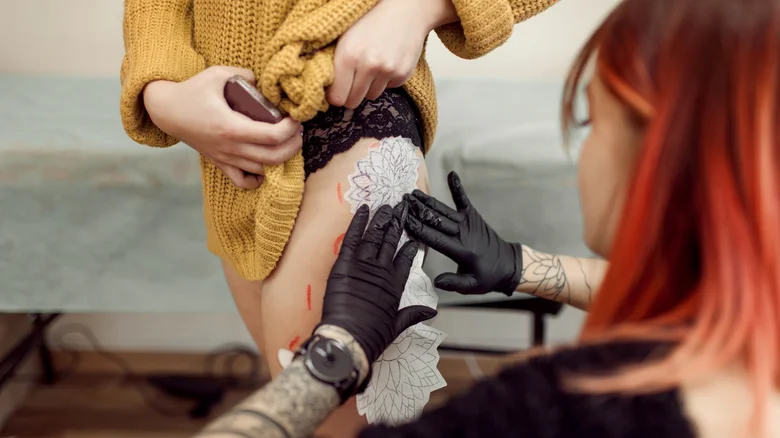
Comfort is obviously important during your tattoo session, but even your most comfortable, stretchy clothing won’t cut it if it gets in the way of the artist. When putting together your outfit for tattoo day, consider what clothing items can be moved, removed, or dispensed with entirely to give your artist full access to their canvas.
“The location of the tattoo, as well as the client’s comfort with undressing, will impact what clothing makes sense to wear,” Rosa Bluestone Perr exclusively tells Glam. Apparently, some clients are happy to strip down to their underwear for the sake of their new tattoo, but Perr implies that this isn’t a requirement or expectation unless your design is going to go somewhere really intimate.
For everyone else, a little forethought and common sense can make all the difference. Getting a tattoo on your arm? Opt for something sleeveless. Getting a tattoo on your calf or thigh? Shorts, or perhaps shorts, may be the way to go. Ribs, lower back, or under the breast? Crop tops, bandeau tops, or even nipple covers are all measures you can take to preserve a bit of modesty while keeping the area clear and accessible. Button-down tops are also a practical option for many different torso tattoo placements, as they can be easily opened, put on and taken off without going over your head, and even worn backwards to keep the front covered during a back tattoo.
Don’t Wear Anything That Absolutely Can’t Get Stained
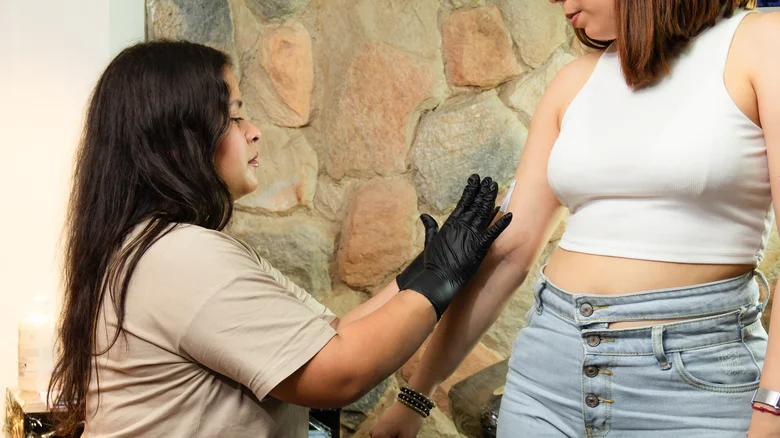
Tattoo artists are professionals who know how to keep their workplace clean. That said, getting a tattoo involves a lot of substances that can stain: not just the ink itself, but also blood, sweat, numbing creams, and moisturizing gels, which can all be present in a typical session. Bottom line: don’t wear anything precious, expensive, or irreplaceable.
With the ever-present risk of staining, it can also be helpful to choose dark-colored clothing for your tattoo appointment. You’ll notice that many tattoo artists wear black while working, and this isn’t just a style choice, though it does look nice. It’s also a practical defense against constant staining. Black or dark-colored clothing is less likely to show ink stains and other messes inherent to the tattooing process, which means it’s also less likely to end up sloppy or even ruined. Sure, there are ways to get those pesky ink stains out of your clothes, but don’t put all your eggs in that basket: Tattoo ink isn’t formulated the same way as regular pen ink, and it may not come out the same way.
Preemptively Remove Any in-the-Way Jewelry
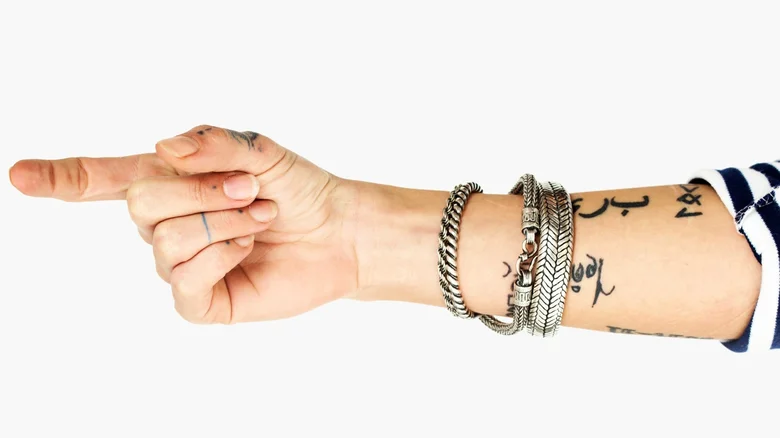
Like certain items of clothing, jewelry and accessories can sometimes get in the way while the artist is trying to work. So don’t be surprised if you have to take them off for your appointment. “If you want a tattoo on your finger or wrist and you’re wearing rings or watches/bracelets, be prepared to take your jewelry off,” Rosa Bluestone Perr exclusively tells Glam.
Of course, not all jewelry is easy to remove. Do yourself a favor and take off any fiddly accessories before you arrive for your appointment. For one, this will save you time and hassle at the salon. And if you’re paying by the hour, every little bit of preparation you can do at home can save you money, too. On the other hand, removing any precious jewelry at home (say, that heirloom ring you typically never take off your finger) reduces the chance of accidentally forgetting or losing it.
The one exception to this rule? If you have a particularly difficult-to-remove piercing along the way to the tattoo, there may be a piercer at the salon who can help you out. Just be sure to ask ahead of time rather than assuming someone will be on call to help you. Otherwise, you can try removing it yourself — you can remove virtually any type of piercing at home with a little care and patience.
Skip Any Clothes That Will be Impractical Afterward
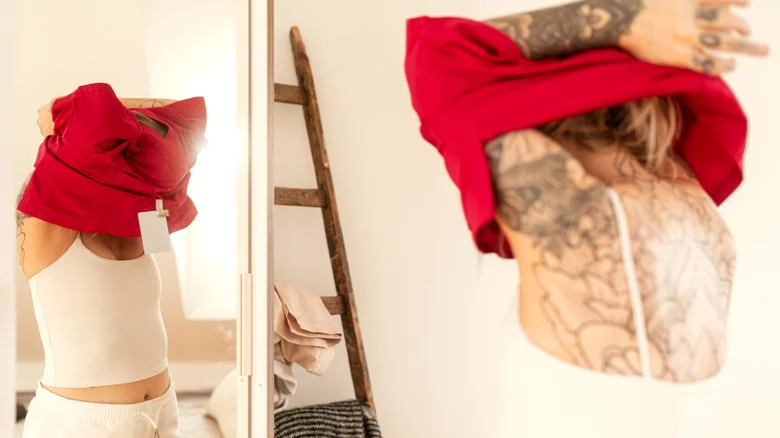
Narrowing down your tattoo attire options to one that’s comfortable, accessible, and stain-resistant during the session, but is appropriate for the weather outside, can be tricky. Fortunately, changing at the studio is always an option. “Some clients strip down to their underwear,” reveals Rosa Bluestone Perr, adding that many others simply choose to bring a more revealing outfit to wear while getting tattooed. “You can always bring a change of clothes to the appointment. For example, if you’re planning on getting a tattoo on your leg but it’s winter and you want to wear pants, you might want to bring a pair of shorts to change into.”
But remember: You’ll also have to take that fresh tattoo home again, so think pragmatically about aftercare. Going back to Perr’s example, it’s easy enough to take off your pants during your tattoo appointment, but can you put them back on to brave the winter cold on the return trip? Skinny jeans or even leggings may not be the best option in this case – consider wearing loose but comfortable sweatpants to keep you warm without putting pressure on your new tattoo.
The same theory applies to anywhere you get a tattoo. From underwear to hoodies, make sure any layer of clothing you put back on after your tattoo session is loose, comfortable, and breathable over your fresh tattoo. Chances are you’ll get a bandage or wrap, but your skin will also be sore, so be forgiving of yourself and choose the season’s more relaxed clothing options.